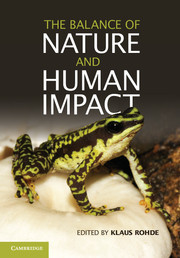Description
The Balance of Nature and Human Impact
Coordinator: Rohde Klaus
Explores equilibrium and non-equilibrium in undisturbed and disturbed ecological systems, examining how human activities affect the balance/imbalance of nature.
Language: English
Subjects for The Balance of Nature and Human Impact:
Publication date: 02-2013
426 p. · 17.8x25.4 cm · Hardback
426 p. · 17.8x25.4 cm · Hardback
Description
/li>Contents
/li>Biography
/li>
It is clear that nature is undergoing rapid changes as a result of human activities such as industry, agriculture, travel, fisheries and urbanisation. What effects do these activities have? Are they disturbing equilibria in ecological populations and communities, thus upsetting the balance of nature, or are they enhancing naturally occurring disequilibria, perhaps with even worse consequences? It is often argued that large-scale fluctuations in climate and sea-levels have occurred over and over again in the geological past, long before human activities could possibly have had any impact, and that human effects are very small compared to those that occur naturally. Should we conclude that human activity cannot significantly affect the environment, or are these naturally occurring fluctuations actually being dangerously enhanced by humans? This book examines these questions, first by providing evidence for equilibrium and non-equilibrium conditions in relatively undisturbed ecosystems, and second by examining human-induced effects.
Preface; Introduction Klaus Rohde; Part I. Nonequilibrium and Equilibrium in Populations and Metapopulations: 1. Reef fishes: density dependence and equilibrium in populations? Graham Forrester and Mark Steele; 2. Population dynamics of ectoparasites of terrestrial hosts Boris Krasnov and Annapaola Rizzoli; 3. Metapopulation dynamics in marine parasites Ana Perez del Omo, Aneta Kostadinova and Serge Morand; Part II. Nonequilibrium and Equilibrium in Communities: 4. The paradox of the plankton Klaus Rohde; 5. A burning issue: community stability and alternative stable states in relation to fire Peter J. Clarke and Mike J. Lawes; 6. Community stability and instability in ectoparasites of marine and freshwater fish Andrea Simkova and Klaus Rohde; 7. Ectoparasites of small mammals: interactive saturated and unsaturated communities Boris Krasnov; 8. A macroecological approach to the equilibrial vs. nonequilibrial debate using bird populations and communities Brian McGill; Part III. Equilibrium and Nonequilibrium on Geographical Scales: 9. Island flora and fauna: equilibrium and nonequilibrium Lloyd Morrison; 10. The turbulent past and future of arctic vascular plants: climate change, spatial variation, and genetic diversity Christian Brochmann, Mary E. Edwards and Inger G. Alsos; Part IV. Latitudinal Gradients: 11. Latitudinal diversity gradients: equilibrium and nonequilibrium explanations Klaus Rohde; 12. Effective evolutionary time and the latitudinal diversity gradient Len Gillman and Shane Wright; Part V. Effects Due to Invading Species, Habitat Loss and Climate Change: 13. The physics of climate: equilibrium, disequilibrium and chaos Michael Box; 14. Episodic processes, invasion and faunal mosaics in evolutionary and ecological time Eric Hoberg and Daniel R. Brooks; 15. The emerging infectious diseases crisis and pathogen pollution Daniel R. Brooks and Eric Hoberg; 16. Establishment or vanishing: fate of an invasive species based on mathematical models Yihong Du; 17. Anthropogenic footprints on biodiversity Camilo Mora and Fernando Zapata; 18. Worldwide decline and extinction of amphibians Harold Heatwole; 19. Climatic change and reptiles Harvey B. Lillywhite; 20. Equilibrium and non-equilibrium in Australian bird communities - the impact of natural and anthropogenic effects Hugh Ford; 21. Population dynamics of insects: impacts of a changing climate Nigel Andrew; 22. The futures of coral reefs Peter Sale; Part VI. Autecological Studies: 23. Autecology and the balance of nature-ecological laws and human induced invasions Gimme Walter; 24. The intricacy of structural and ecological adaptations: micromorphology and ecology of some Aspidogastrea Klaus Rohde; Part VII. An Overall View: 25. The importance of interspecific competition in regulating communities, equilibrium vs. nonequilibrium Klaus Rohde; 26. Evolutionarily stable strategies: how common are they? Klaus Rohde; 27. How to conserve biodiversity in a nonequilibrium world Klaus Rohde, Hugh Ford, Nigel R. Andrew and Harold Heatwole; Index.
Klaus Rohde is Professor Emeritus at the University of New England, Armidale, Australia. He is well known for his work on the ecology, biogeography and ultrastructure of parasites, particularly marine parasites, and on latitudinal gradients in biodiversity. He had published extensively on parasite ecology, nonequilibrium ecology and marine parasitology.
© 2024 LAVOISIER S.A.S.
These books may interest you

Global Climate and Ecosystem Change 158.24 €



